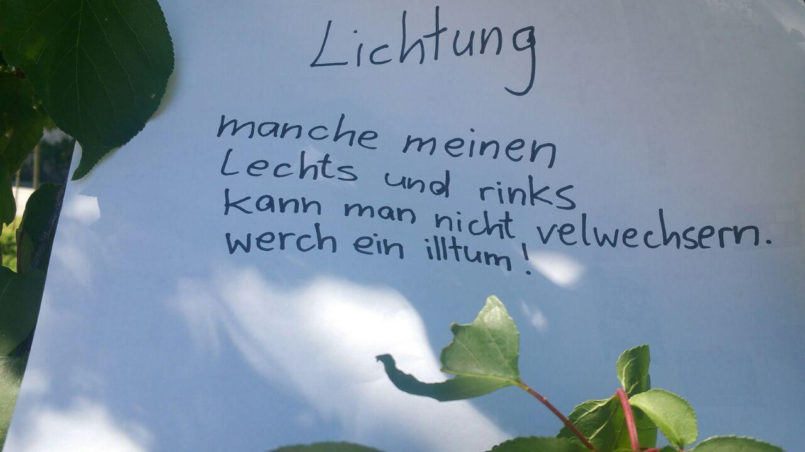How right-winged is Europe?

Since the 90s, Andreas Peham has worked in the Documentation Archive of the Austrian Resistance Movement – an archive which was founded by people who were part of the resistance and which is committed to the resistance against National Socialism. There he is active in the research of right-winged extremism.
Peham’s tasks include:
- Monitoring – Observation of all aspects of right-winged extremism
- Analysis and Publication of the results of the monitoring (under the synonym Heribert Schiedel)
- Prevention work, political educational work and clarification – above all in schools
Regarding the monitoring, Peham reports that it starts on the extreme right, the so called neo-Nazism – this scene is very violent and their observations, especially the participatory observation, can be dangerous.
We could say that neo-Nazism is violent right-winged extremism, which positively refers to National Socialism. This positive referenc very often takes the forms of denial, relativization and approval or trivialization of NS crimes.
Peham deliberately uses these four terms, as they can be found in the Prohibition Act. The Prohibition Act delineates the border within the extreme right, a border which separates an anti-constitutional illegal part from a still democratically permitted part of right-winged extremism.
With respect to research, in order to gain as good an insight as possible into this scene, the archive has ‘people outside’ who provide the archive with material from this scene, as the neo-Nazis obviously do not voluntarily make their magazines available for the archive.
The internet and, above all, new social media, which are jointly responsible for the extreme right gaining strength in Europe, or I would even say globally in the last 20 years, are becoming increasingly significant.
Peham stresses that he recognises a global process, which points to global causes. He does not include the internet in the main reasons, but he puts forward the thesis that the structures of the internet and new social media accommodate the extreme right.
Then there is the extreme right, still within the constitutional “arch” – in the opinion of Peham the party-shaped right-winged extremism – in Austria covered by the FPÖ, which surely belongs to the avant-garde in Europe and which he believes can be regarded as pioneers of a European right-winged extremism, especially here Andreas Mölzer – also to the pioneers of what he calls an extreme right-winged fraction in the European Parliament, which has again existed since June 2015.
The extreme right also includes right-wing populism, which in Austria is covered by Team Stronach and the BZÖ, which is, however, no longer of significance.
How right-winged is Europe?
How anti-democratic or undemocratic is Europe on an institutional level?
Peham sees a connection between the constitutionality of Europe, the reality of the EU and the strengthening of right-winged extremism and right-winged populism in individual countries of Europe.
What has happened to the validity of Europe?
In the early 1990s, Étienne Balibar pointed out the dilemma of the European Union in an essay entitled: “There is no State in Europe”, when he wrote that a state can either be democratic or not democratic, but a non-state, such as the EU, can, by definition, not be democratized.
From a political science perspective, this is a big problem. The European Union either arrived at a stillstand during the process of the merger of national states to a federal state – which would be the integration process – or was deliberately held in this intermediate position.
Different interests reinforced and helped each other to hold the EU in this intermediate position. Peham stresses that there is no state in Europe; powers and sovereignty were submitted to Brussels from the national parliaments – which would not be a problem, but the crux is that, on a European level, no equivalent to the nation state exists.
There is no democracy in Europe, the European Parliament is, despite all the reforms and constitution, not a parliament, which deserves its name; it is not a legislature. It gained more control rights, it also received more legislative powers, but it is still far from being a parliament.
And that is the problem: national parliaments handed over powers to a place which is less democratic. Regarding this, the EU is described as a black hole, with the result that reference is made to post-democracy. And this loss of democracy from above obviously strengthens the anti-democratic resentments below – and thus the extreme right.
As long as the EU is in this intermediate position, the extreme right will find good conditions and gain strength, and, therefore, it would be the task of a left-winged or a party opposed to the extreme right on the European level to either promote integration or to go back to the national states.
Then there would be the “Europe of Nations” or “Fatherlands” which the extreme right, the conservatives, want, but it would still be better than this current intermediate state, as this would be a weakening of democracy – simply a non-state, which cannot be democratized and we should get away from this condition as quickly as possible.
The eastward expansion of the EU
The eastward expansion brought a shift to the right to Europe. Probably everyone knows about the east-west gap, as regards democracy, racism, homophobia and anti-Semitism. This has historical reasons, but also the political constitution in the countries, and not only since Orbán and Kaczyński, would actually not have allowed accession to the EU. Now Europe is watching Hungary eroding democracy.
In the so-called “refugee crisis” the dominant attitudes were presented. As the government sees it, it has to be said that they are, at least formally, still democracies.
How right-winged is Europe on a party level?
In 2014 the last election for the European Parliament took place, with a contradicting shift to the right, as it was not a landslide victory for the extreme right, there was a relative balance between the winners and the losers. But a tendency could be seen; namely that those moderate right-winged parties which were rather right-winged populists, by all means did win.
It is also important to mention that the rather moderate, rather right-winged populist parties developed and no longer wanted to have anything to do with the extreme right. But there is also the opposite tendency in the Member States, namely that the former right-winged populist parties became radicalized and developed into extreme right-winged parties, such as the Party for Freedom of Geert Wilders. Previously they did not want to have anything to do with the FPÖ but, since 2013, they have been closely linked with the FPÖ. Just as the Lega Nord from Italy – Umberto Bossi did turn down all cooperation with Haider, but today they are very closely linked, and have even been in a fraction in the European Parliament since 2015.
How was it possible for previously hostile political forces to merge?
Ultimately there has also been a change here. In 2007 it was possible for the first time to form a fraction, but this did not last for a long time but rather broke down due to nationalism and resentments. Since 2015, the fraction “Movement for a Europe of Nations and Freedom” has existed once again. This fraction is held together by common fear, which H.C. Strache expresses as follows: “We are European brothers, because we don’t want to become ‘islamisied’!”
The ‘Europeanisation’ of right-winged extremism was, therefore, possible due to a common enemy – Islam, Islamisation; there is, however, here a further common enemy: the European Union and Brussels, because many were dissatisfied with the process of integration.
Regardless of on which level, the extreme right considers itself strengthened and it is so, as long as we do not succeed in opposing this also on the European level, on the one hand against the Europe of Nations and, on the other hand, for a possible European federal state.
Translation into English: Anna Stockenhuber
Credits
| Image | Title | Author | License |
|---|---|---|---|
 |
Lichtung by Ernst Jandl | Patryk Kopaczynski | CC BY-ND 2.0 |
